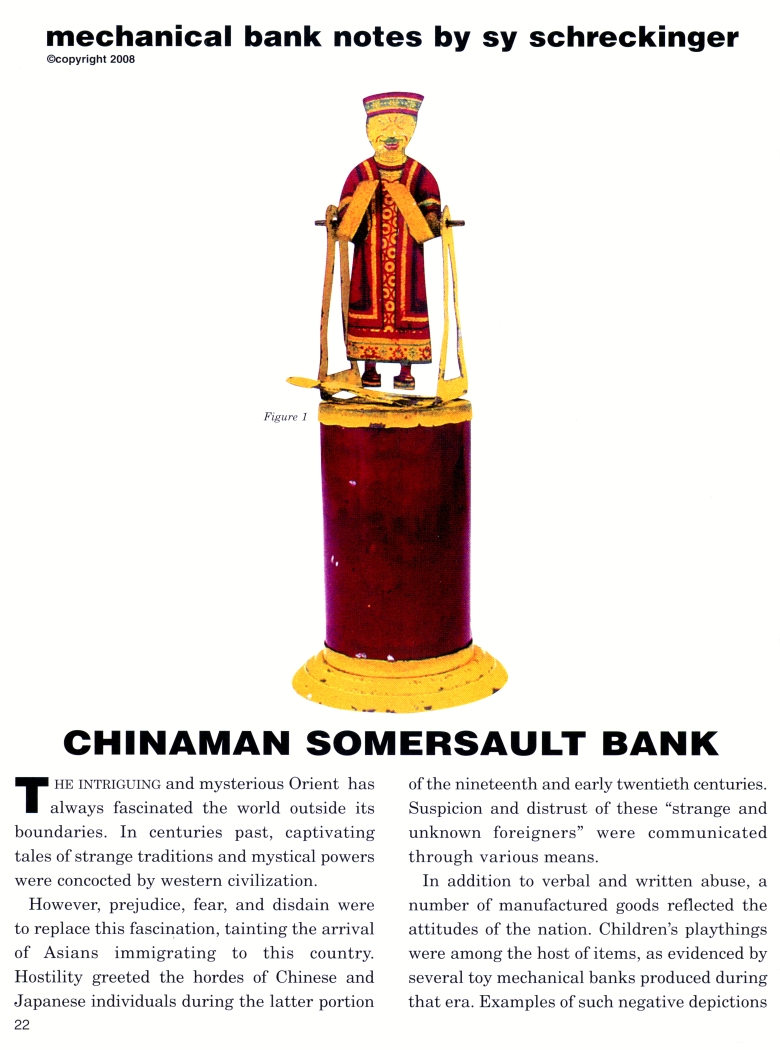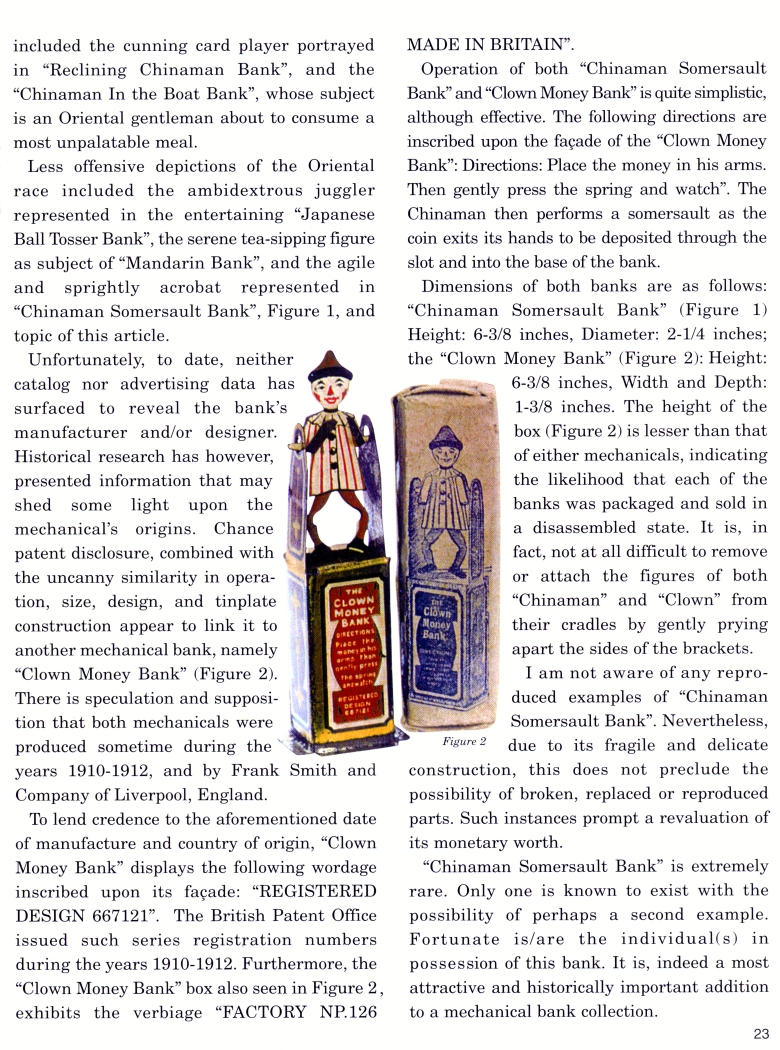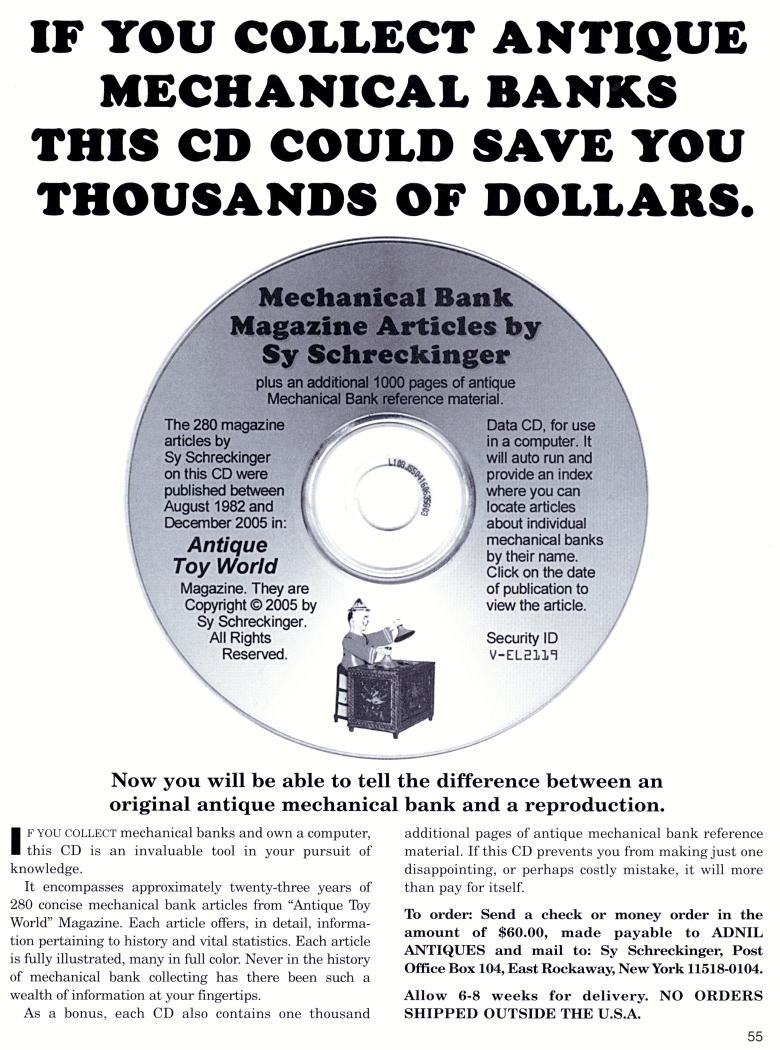|
Chinaman Somersault Bank
by Sy Schreckinger – ANTIQUE TOY WORLD Magazine – July, 2008
The intriguing and mysterious Orient has always
fascinated the world outside its boundaries. In centuries past,
captivating tales of strange traditions and mystical powers were concocted
by western civilization.
However, prejudice, fear, and disdain were to replace this
fascination, tainting the arrival of Asians immigrating to this country.
Hostility greeted the hordes of Chinese and Japanese individuals during
the latter portion of the nineteenth and early twentieth centuries.
Suspicion and distrust of these "strange and unknown foreigners" were
communicated through various means.
In addition to verbal and written abuse, a number of manufactured
goods reflected the attitudes of the nation. Children's playthings were
among the host of items, as evidenced by several toy mechanical banks
produced during that era. Examples of such negative depictions included
the cunning card player portrayed in "Reclining Chinaman Bank", and the
"Chinaman In the Boat Bank", whose subject is an Oriental gentleman about
to consume a most unpalatable meal.
Less offensive depictions of the Oriental race included the
ambidextrous juggler represented in the entertaining "Japanese Ball Tosser
Bank", the serene tea-sipping figure as subject of "Mandarin Bank", and
the agile and sprightly acrobat represented in "Chinaman Somersault Bank",
Figure 1, and topic of this article.
Unfortunately, to date, neither catalog nor advertising data has
surfaced to reveal the bank's manufacturer and/or designer. Historical
research has however, presented information that may shed some light upon
the mechanical's origins. Chance patent disclosure, combined with the
uncanny similarity in operation, size, design, and tinplate construction
appear to link it to another mechanical bank, namely "Clown Money Bank"
(Figure 2). There is speculation and supposition that both mechanicals
were produced sometime during the years 1910-1912, and by Frank Smith and
Company of Liverpool, England.
To lend credence to the aforementioned date of manufacture and
country of origin, "Clown Money Bank" displays the following wordage
inscribed upon its facade: "REGISTERED DESIGN 667121". The British Patent
Office issued such series registration numbers during the years 1910-1912.
Furthermore, the "Clown Money Bank" box also seen in Figure 2 exhibits the
verbiage "FACTORY NP.126 MADE IN BRITAIN".
Operation of both "Chinaman Somersault Bank" and "Clown Money Bank"
is quite simplistic, although effective. The following directions are
inscribed upon the facade of the "Clown Money Bank": Directions: Place the
money in his arms. Then gently press the spring and watch". The Chinaman
then performs a somersault as the coin exits its hands to be deposited
through the slot and into the base of the bank.
Dimensions of both banks are as follows: "Chinaman Somersault Bank"
(Figure 1) Height: 6-3/8 inches, Diameter: 2-1/4 inches; the "Clown Money
Bank" (Figure 2): Height: 6-3/8 inches, Width and Depth: 1-3/8 inches. The
height of the box (Figure 2) is lesser than that of either mechanicals,
indicating the likelihood that each of the banks was packaged and sold in
a disassembled state. It is, in fact, not at all difficult to remove or
attach the figures of both "Chinaman" and "Clown" from their cradles by
gently prying apart the sides of the brackets. I am not aware of any
reproduced examples of "Chinaman Somersault Bank". Nevertheless, due to
its fragile and delicate construction, this does not preclude the
possibility of broken, replaced or reproduced parts. Such instances prompt
a revaluation of its monetary worth.
"Chinaman Somersault Bank" is extremely rare. Only one is known to
exist with the possibility of perhaps a second example. Fortunate is/are
the individual(s) in possession of this bank. It is, indeed a most
attractive and historically important addition to a mechanical bank
collection.
If you collect Antique
Mechanical Banks this
CD could save you Thousands of Dollars
by Sy Schreckinger – ANTIQUE TOY WORLD Magazine – July, 2008
Now you will be able to tell the difference
between an original antique mechanical bank and a reproduction.
IF YOU COLLECT mechanical banks and own a computer, this CD is an
invaluable tool in your pursuit of knowledge.
It encompasses approximately twenty-three years of 280 concise
mechanical bank articles from "Antique Toy World" Magazine. Each article
offers, in detail, information pertaining to history and vital statistics.
Each article is fully illustrated, many in full color. Never in the
history of mechanical bank collecting has there been such a wealth of
information at your fingertips.
As a bonus, each CD also contains one thousand additional pages of
antique mechanical bank reference material. If this CD prevents you from
making just one disappointing, or perhaps costly mistake, it will more
than pay for itself.
To order: Send a check or money order in the amount of $60.00, made
payable to ADNIL ANTIQUES and mail to: Sy Schreckinger, Post Office Box
104, East Rockaway, New York 11518-0104.
Allow 6-8 weeks for delivery. NO ORDERS SHIPPED OUTSIDE THE U.S.A.
|



